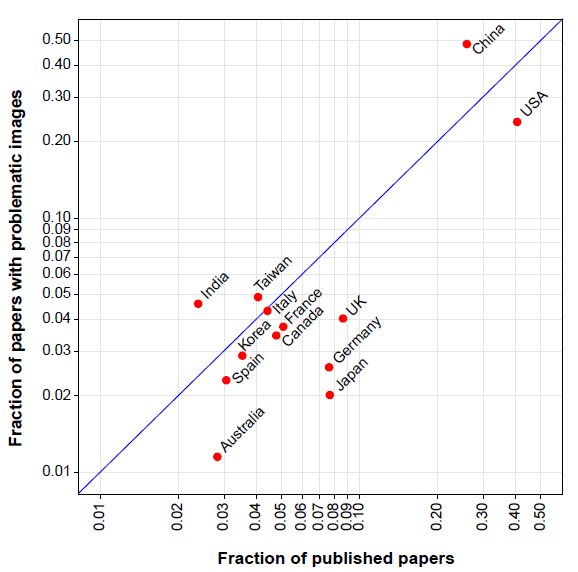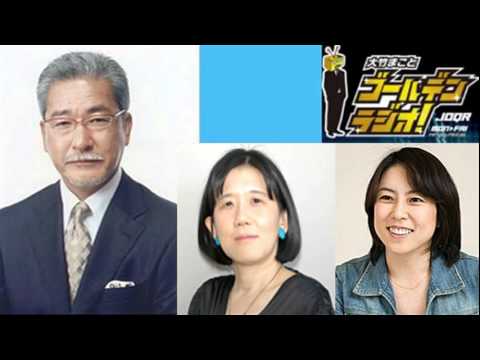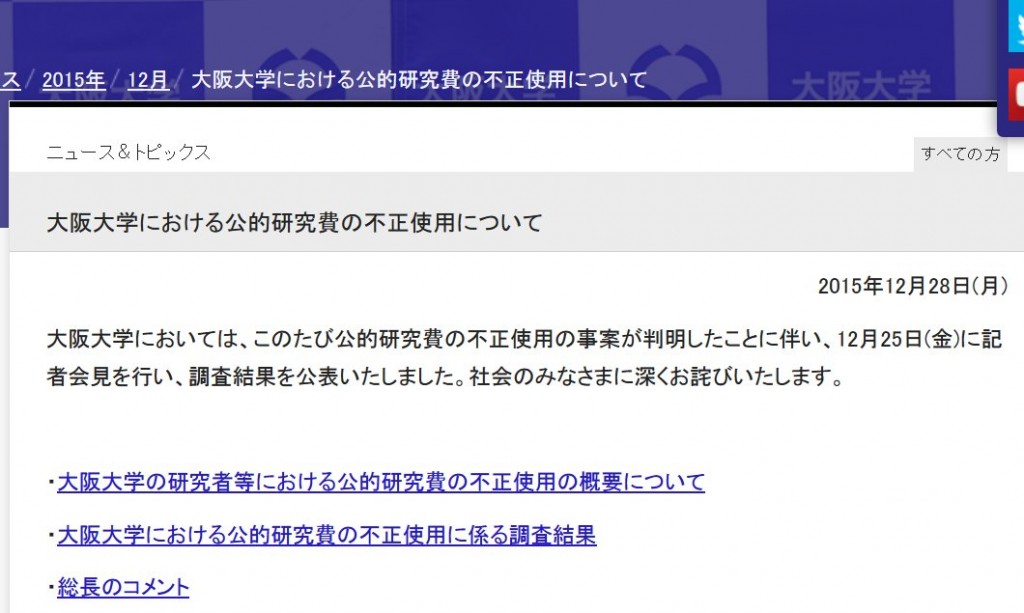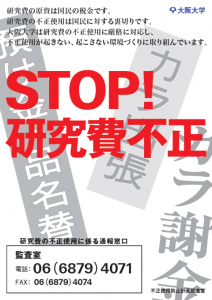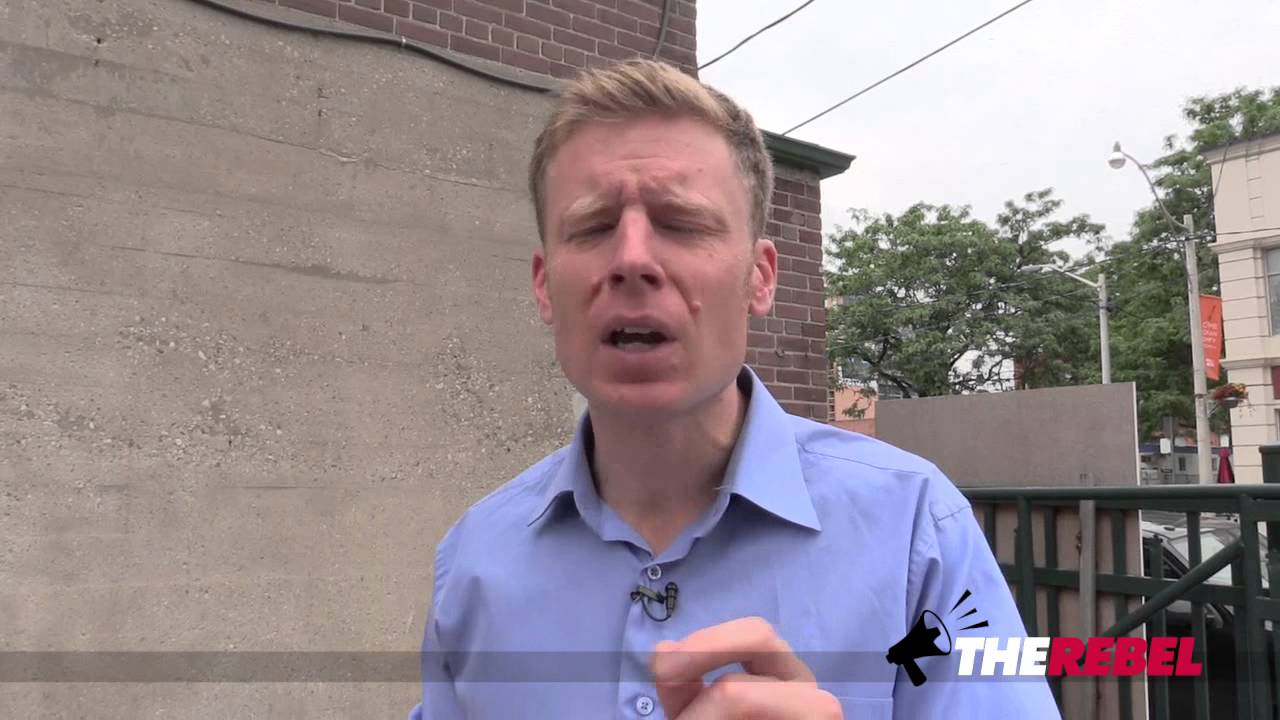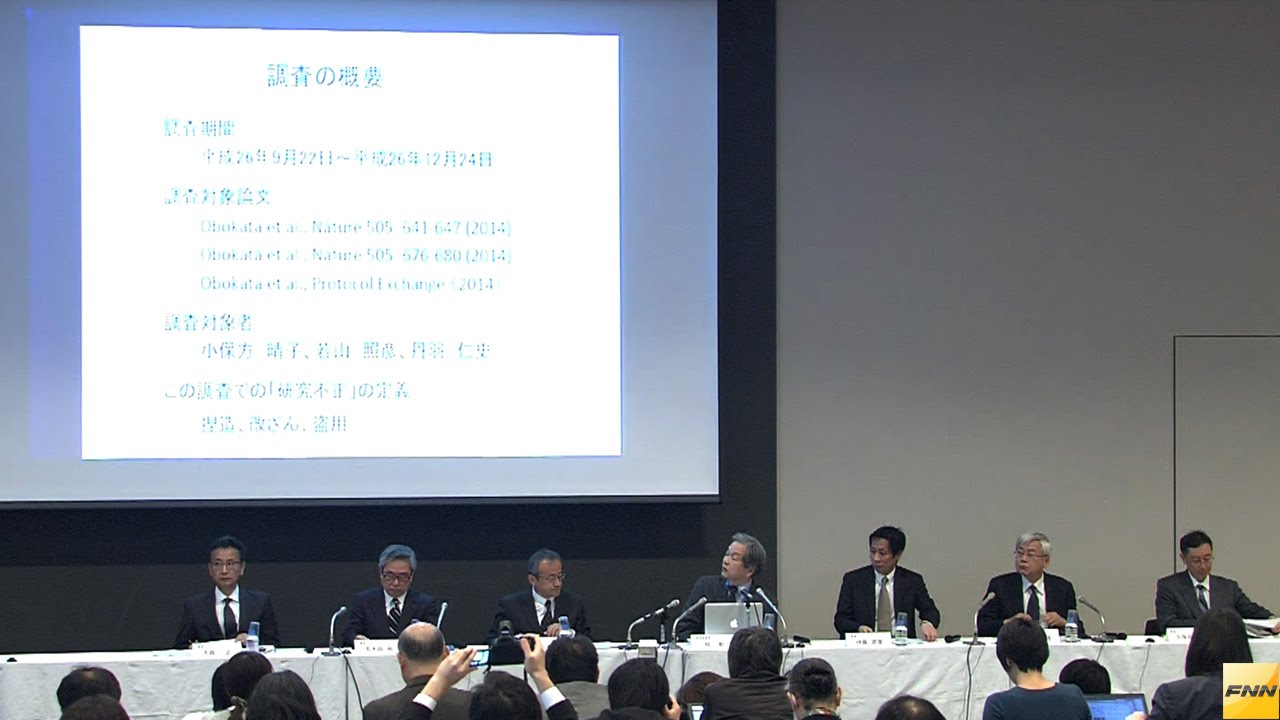追記 20170205 2015年にネットで公開されていた、画像データの類似性を解説したPDFファイル r3hso.pdf (https://t.co/zfttZKmgZr)。
追記 関連記事
⇒ 東京大学が類似画像論文に関する予備調査結果を発表: ”不正行為が存在する疑いはない”論文12報のリスト
⇒ 大阪大学、類似画像データ論文の調査を打ち切り 本調査を行わないことを決定
——–
日本分子生物学会2013年年会組織委員会がシンポジウム「生命科学を考えるガチ議論」のための準備としてウェブ上に設置した議論用のサイトで、「日本の科学を考える」(http://scienceinjapan.org/)というものがあります。このウェブサイト上で、年末年始の数日間の間に、異なる実験結果に同一画像データが使いまわされている可能性のある「画像酷似論文」が大量に指摘されました。NATUREを筆頭に、NATUREの姉妹紙など一流の雑誌を含めて、全部で84報に上ります。「捏造問題にもっと怒りを」の記事のコメント欄を利用して書き込まれました。
画像酷似論文の指摘を行った匿名A氏は、このウェブサイト「日本の科学を考える」を選んだ心情を吐露しています。
申し訳ありませんが、やはり、投下させてください。
このサイトを使わせてください。
このガチ議論スタッフは、科学の世界の王になるべき人達です。
情報や権限を持つべき人です。
わたしは2ちゃんねるではなく、ガチ議論スタッフに科学の未来を委ねたいと思います。
すなわち、科学の世界に生きる私自身を、2ちゃんねるではなくガチ議論スタッフに委ねたいということです。
わたしは、捏造に本当に苦しんだ人間です。
前任者の捏造が何を現場で生むか、知っています。
現場を本当に救うのはどんな人か、知っています。
そのような人でなければこのサイトは作れないことを、知っています。
膿みは、今出すべきです。
STAPと分生研が終わって一段落なんて雰囲気は許しません。
それに、東大の事例を考えるに、コピペがあっても半分近くは不正ではない。
さらにその半分くらいは実行犯がわからない。
コピペの指摘はそこまで重いものではないということです。
ストックは82報になりました。コレスポ53人。
旧帝を全部揃えることも出来ました。
最近疎かだった同じ著者について掘り下げることをまた始めます。100はすぐ超えて、悪質なグループだけに投下を絞ることも出来るでしょう。
匿名A氏は、ここで指摘された論文の著者らが直ちに実験ノートを公開すれば画像が酷似していることに関する疑問も氷解するであろうと期待しています。
以下、80報ほどの類似画像を含む論文を記載しました。(中略)トータルで100報にはなりました。(中略)全 部当然生データが直ぐに公開され、石井先生のようにうっかりミスと納得できますように。私は石井先生のすぐ公開されたノートを見て、石井先生はしっかりし た先生だと思いました。私の中の石井先生の評価は非常に上がりました。他にもそう思った人は少なくないはずです。私が論文を紹介した他の先生についても評 価が上がることを心から強く願っています。この気持ちは嘘ではありません。
匿名A氏の説明によれば、特定の個人を告発する意図で調べたわけではなく、手当たり次第に調べてみたらこのような結果になってしまったようです。あまりの多さに途中で疲れて作業を切り上げてしまったそうなので、もしも網羅的に調査したら84報どころではなくなるかもしれません。特定の大学を告発する意図もなかったようですが、結果的に、画像酷似論文の多さに関しては大阪大学医学部が際立っていたそうです。
(中略)
・ 阪大医学部で、他の組織とは別次元のことが起きているのは確かなように感じました。各コレスポにつき最低3報を目標に探していたのですが、類似の著者陣でもコレスポが異なるケースが多く、しかも類似画像が瞬時に見つかる確率が高く、次々とノルマが増えていき、悲しくなりました。類似画像の世界では、3位ではなく、すでに1位ではないかと思います。3位ではダメと言う総長は、少し自らを過小評価しているかもしれません。(中略)
・ 調査の過程ですが、まず東大から探そうと思い、TokyoをキーワードにPubmed検索で探しました。探すのは何となく1998年から2004年くらい にしました。キーワードの関係上、東大以外の東京の研究機関も見つかりました。MedicalやMedicineで検索結果を絞ると見つかる確率が飛躍的 に上がることに途中で気づき、途中で絞りました。見つかった著者の他の論文も探しました。研究費返還の事務手続きを事務の方々がしなくて済むように、経理 書類の保存義務が過ぎているであろう2008年くらいまでの論文だけを探しました。次にOsakaをキーワードにして探しました。見つかる頻度が高すぎ て、バランスが悪くなると思い、ひとまず他の地域を探すことにしました。旧帝国大学で、それまでに見つかる論文数が多かったJBC誌とBBRC誌を 1998年から2004年まで探すことにしました。キーワードの関係上、旧帝国大学と同じ所在地の研究機関も見つかりました。見つかった著者の他の論文も 調べました。最後に大阪に戻り、再び探したのですが、見つかる頻度の高さに馬鹿らしくなり、やめました。大阪を終えたら次にOncogene誌あたりを全 部探してみようと思ってましたが、大阪の調査で精神的に疲れたので結局探していません。上記以外に、途中で気分転換にアディポネクチン等をキーワードにし て探したこともあったかもしれません。また、最終的に投下しなかった13報の論文がそのチームに気づくきっかけになった場合もあります。
「類似画像=捏造」とは限らないことに関して、匿名A氏は注意を促しています。
私は自分が指摘した類似画像を捏造だとは思っていません。
そもそも、私には捏造だと判定し処分する権利はありません。
理研の石井先生の疑惑を最初に見たときは、捏造だと私は内心思っていました。しかし、すぐに公開された実験ノートを見て、こんな複雑なうっかりミスもあるんだなと納得しました。(以下略)
匿名A氏が列挙した論文は以下の通りです。括弧内の但し書きは匿名A氏自身が後から追加したコメントの内容。
#1 Nature. 1998 Jan 1;391(6662):96-9. http://www.ncbi.nlm.nih.gov/pu… Fig 1a. Lane 1 is similar to Lane 5. Lane 6 is similar to Lane 10.
#2 J Biol Chem. 2000 Mar 17;275(11):8091-6. http://www.ncbi.nlm.nih.gov/pu… Fig 3A. Lane 3 is similar to Lane 8, 9, and 10. Fig 3B. Lane 1 is similar to Lane 2.
#3 Arch Biochem Biophys. 2001 Apr 1;388(1):91-9. http://www.ncbi.nlm.nih.gov/pu… Fig 2A. Lanes 2-3 are similar to lanes 9-10. Fig 4B. Lanes 2-3 are similar to lanes 9-10.
#4 Diabetes. 2002 Oct;51(10):2915-21. http://www.ncbi.nlm.nih.gov/pu… Fig 5. 18S of B is similar to that of C (horizontal flip).
#5 Nat Med. 2002 Jul;8(7):731-7. Epub 2002 Jun 17. http://www.ncbi.nlm.nih.gov/pu… Fig 1b. +/- is partially similar to -/-. Fig 2. 18S of a is similar to that of b. Fig 5a. 28s of TNF-alpha(-) and Adiponectin(+) is similar to that of TNF-alpha(+) and Adiponectin(+).
#6 J Biol Chem. 2003 Jun 13;278(24):21344-51. Epub 2003 Apr 1. http://www.ncbi.nlm.nih.gov/pu… Fig 5. Lane 2 is partially similar to lane3.
#7 Mol Cell Biol. 1996 Jun;16(6):3074-84. http://www.ncbi.nlm.nih.gov/pu… Fig 7C. Lane a is similar to Lane b.
#8 J Biol Chem. 2001 Nov 2;276(44):41245-54. Epub 2001 Aug 31. http://www.ncbi.nlm.nih.gov/pu… Fig 4G. PIPs are similar to those of Fig. 5d in another paper (J Clin Invest. 2001 Oct;108(7):1001-13. #9 in this list.) The dates of revision and publication of this paper are earlier than the other paper. (#8は、どちらかといえば、The date of submission of this paper is later than that of #9. と書くべきでした。)
#9 J Clin Invest. 2001 Oct;108(7):1001-13. http://www.ncbi.nlm.nih.gov/pu… Fig 6b. The CD36 band in the lane HF is similar to the UCP2 band in the lane HF+BADGE (horizontal flip). The CD36 band in the lane HF+BADGE is similar to the UCP2 band in the lane HF+HX531 (horizontal flip).
#10 Nat Genet. 2002 Feb;30(2):221-6. Epub 2002 Jan 30. http://www.ncbi.nlm.nih.gov/pu… Fig 6. 28S in a (WAT) is similar to that of in d (BAT).
#11 Biochem Biophys Res Commun. 2004 Oct 8;323(1):242-8. http://www.ncbi.nlm.nih.gov/pu… Fig 2A. The control lanes are similar to the salicylate lanes. Fig 3B. p-Akt in Lane 3 is similar to that in Lane 7. p-Akt in Lane 5 is similar to that in Lane 6. Akt in Lane 4 is similar to that in Lane 6. Fig 4. Lane 5 is similar to Lane 7 (horizontal flip).
#12 J Biol Chem. 2001 Jul 20;276(29):27519-26. Epub 2001 May 24. http://www.ncbi.nlm.nih.gov/pu… Fig 6. E is similar to f. Fig 9. D is similar to e and f (enlarge).
#13 Exp Cell Res. 2002 Jan 1;272(1):23-31. http://www.ncbi.nlm.nih.gov/pu… Fig7. Bone marrow cells of LZP is similar to those of CRP.
#14 Oncogene. 2002 Jan 24;21(5):844-8. http://www.ncbi.nlm.nih.gov/pu… Fig 1b. These figures (HUVEC and ST2 cells) are similar to those of the COS7 cells in another paper (Fig. 6 in J Biol Chem. 2001 Jul 20;276(29):27519-26. #12 in this list.)
#15 Biochem Biophys Res Commun. 2002 Apr 26;293(1):332-7. http://www.ncbi.nlm.nih.gov/pu… Fig 1. The mice of 2 weeks are similar to those of 3 weeks (vertically enlarge).
#16 J Virol. 1999 Nov;73(11):9237-46. http://www.ncbi.nlm.nih.gov/pu… Fig 5B. Some bands seem to be pasted in the figures. For example, lane 3 in the left SeV/mSF figure.
#17 J Virol. 2000 Jun;74(12):5619-28. http://www.ncbi.nlm.nih.gov/pu… Fig 2A. In the upper figure, 4C(-) 20 is simiar to 4C(-) 26. Fig 2B. GAPDHs of Wt 14, Wt 38, 4C(-) 14, and 4C(-) 20 are similar.
#18 J Virol. 2001 Apr;75(8):3802-10. http://www.ncbi.nlm.nih.gov/pu… Fig 4C. Y1+ is similar to Y2+.
#19 J Virol. 2002 Jul;76(14):7114-24. http://www.ncbi.nlm.nih.gov/pu… Fig 4B. Y2.5+ is similar to Y3+.
#20 J Virol. 2004 Jul;78(14):7443-54. http://www.ncbi.nlm.nih.gov/pu… Fig 5. STAT2 of None is similar to that of Cm5.
#21 J Virol. 2007 Apr;81(7):3264-71. Epub 2007 Jan 10. http://www.ncbi.nlm.nih.gov/pu… Fig 4. In the most upper figure, Sev Wt 0 is similar to Sev Wt 6 in both 2fTGH STAT1(+/+) cells and U3A STAT1(-/-) cells.
#22 Biochem Biophys Res Commun. 2002 Aug 9;296(1):194-200. http://www.ncbi.nlm.nih.gov/pu… Fig 3A. Lane 1 is similar to Lane2 for GluSyn.
#23 Biochem Biophys Res Commun. 2001 Nov 30;289(2):531-8. http://www.ncbi.nlm.nih.gov/pu… Fig 1 and Fig 2. 18S rRNA of Lane 2 (monocytes) in Fig 1 is similar to that of Lane 2 (alpha-GalCer-imDCs) in Fig 2.
#24 Circ Res. 2004 Jun 11;94(11):1492-9. Epub 2004 Apr 29. http://www.ncbi.nlm.nih.gov/pu… Fig 2 and Fig 3. E1A in the lanes 1-2 of Fig 2A is similar to that in the lanes 2-3 of Fig 3C.
#25 J Biol Chem. 2002 Apr 5;277(14):12351-8. Epub 2002 Jan 22. http://www.ncbi.nlm.nih.gov/pu… Fig 1B. D is similar to g. Fig 3B. The right part of Myc-MST1 WT is similar to that of Flag-MST1 444P.
#26 J Biol Chem. 1999 Apr 23;274(17):11995-2000. http://www.ncbi.nlm.nih.gov/pu… Fig 4. EDTA is similar to Fuc.
#27 J Biol Chem. 2000 Jun 9;275(23):17233-6. http://www.ncbi.nlm.nih.gov/pu… Fig 2B. Input of 0-45 is similar to that of 90-180. Fig 4. ECT2-N1(-) 45 is simialr to ECT2-N1(+) 45.
#28 J Biol Chem. 2002 Dec 27;277(52):50966-72. Epub 2002 Oct 21. http://www.ncbi.nlm.nih.gov/pu… Fig 2B and Fig 4C. The actin in Fig 2B is similar to that of Fig 4C (horizontally flip.) Fig 4C and Fig 5D. The six COX bands in Fig 5D is similar to six bands of actin in Fig 4C.
#29 J Biol Chem. 2001 Mar 23;276(12):9460-7. Epub 2000 Dec 19. http://www.ncbi.nlm.nih.gov/pu… Fig 1B. In the lower figure, RET-2B is similar to RET-2B/LAR.
#30 J Biol Chem. 1999 Dec 31;274(53):38251-9. http://www.ncbi.nlm.nih.gov/pu… Fig 2A. 37 degrees Celsius is partially similar to 30 degrees Celsius.
#31 Nucleic Acids Res. 2000 Mar 15;28(6):1355-64. http://www.ncbi.nlm.nih.gov/pu… Fig 7A. 18S rRNA of placenta is similar to that of mammary gland in another paper (Fig 2A in Mol Biol Cell. 1999 May;10(5):1637-52.)
#32 DNA Repair (Amst). 2007 Jun 1;6(6):760-9. Epub 2007 Feb 5. http://www.ncbi.nlm.nih.gov/pu… Fig 5A. GAPDH of W in 5 weeks is similar to that of SP in 16 weeks.
#33 J Biol Chem. 2000 Aug 18;275(33):25146-54. http://www.ncbi.nlm.nih.gov/pu… Fig 6D. pMAPK of S10A is similar to that of WT-DMSO (horizontally flip). You can pay attention to the noise of the rim.
#34 J Biol Chem. 2002 Apr 26;277(17):14355-8. Epub 2002 Mar 11.
http://www.ncbi.nlm.nih.gov/pu… Fig 1B. Tubulin in cytoplasm is similar to that in whole cell.
#35 EMBO J. 2002 Dec 2;21(23):6312-20. http://www.ncbi.nlm.nih.gov/pu… Fig 2C. p47phox is similar to p67phox.
#36 J Biol Chem. 2003 Jul 4;278(27):25234-46. Epub 2003 Apr 25. http://www.ncbi.nlm.nih.gov/pu… Fig 3A. The two lower left cells are similar between wt and P156Q.
#37 J Biol Chem. 2003 Jun 20;278(25):22908-17. Epub 2003 Apr 7. http://www.ncbi.nlm.nih.gov/pu… Fig 2. MRP11-116/MRP2 is similar to MRP11-1480/MRP2.
#38 J Virol. 1999 Oct;73(10):7981-7. http://www.ncbi.nlm.nih.gov/pu… Fig 1A. Lane 1 is similar to Lane 3 and 6. Lane 2 is similar to Lane 8. Lane 4 is similar to Lane 7.
#39 J Biol Chem. 2002 Jan 18;277(3):2132-7. Epub 2001 Oct 22. http://www.ncbi.nlm.nih.gov/pu… Fig 2b. The FLAG band of GST-WT is similar to the GST band of WT-WT. Fig 3A. The left upper figure is similar to the left lower figure (horizontally flip).
#40 J Biol Chem. 2004 Jun 11;279(24):25474-82. Epub 2004 Mar 22. http://www.ncbi.nlm.nih.gov/pu… Fig 5A. Lanes 8-9 are similar to lanes 12-13.
#41 Diabetes. 2003 Nov;52(11):2657-65. http://www.ncbi.nlm.nih.gov/pu… Fig 3B. APS bands in GFP lanes seem to be pasted in. IR beta bands in GFP lanes are similar to those in APS(YF) lanes.
#42 J Biol Chem. 1999 Nov 5;274(45):32309-17. http://www.ncbi.nlm.nih.gov/pu… Fig 4A. Lane 1 is similar to Lane 15 (horizontally flip). Lanes 12-13 are similar to Lane 16-17 (horizontally flip).
#43 J Biol Chem. 2000 Sep 1;275(35):26856-63. http://www.ncbi.nlm.nih.gov/pu… Fig 9C. Mock-transfected cell (-) is somewhat similar to Mutant probe (-). Mock-transfected cell oligo TRE is somewhat similar to Mutant probe Ang II.
#44 J Biol Chem. 2000 Feb 11;275(6):4369-73. http://www.ncbi.nlm.nih.gov/pu… Fig 3. GAPDHs of Time 4, 5, and 6 are similar in PAO+. Fig 4. iNOS mRNA of Lane +-+- is similar to that of Lane +–+.
#45 Hepatology. 2000 Nov;32(5):1037-44. http://www.ncbi.nlm.nih.gov/pu… Fig 3. 3h None is similar to 5h Hypo.
#46 J Hepatol. 2004 Apr;40(4):616-23. http://www.ncbi.nlm.nih.gov/pu… Fig 4A. Phospho-Akt of 2h(-) is similar to that of 2h(+).
#47 Am J Physiol Endocrinol Metab. 2005 May;288(5):E876-82. Epub 2004 Dec 21. http://www.ncbi.nlm.nih.gov/pu… Fig 4A. 28S and 18S in lanes 1-6 are similar to those in another paper (Fig 1A in Biochem Biophys Res Commun. 2004 May 14;317(4):1075-9.)
Fig 5A. In the adiponectin bands, Lanes 1-4 are similar to lanes 12-15. Lanes 6-7 are similar to lanes 9-10.
#48 Biochem Biophys Res Commun. 2001 Apr 27;283(1):255-9. http://www.ncbi.nlm.nih.gov/pu… Fig 2. V/Vsp in lanes 1-3 is similar to V/Vsp in lanes 7-9, STAT1 in lanes 10-12, and STAT1 in lanes 13-15. IRF9 in lanes 10-12 are similar to that in lanes 13-15.
#49 J Virol. 2002 Dec;76(24):12683-90. http://www.ncbi.nlm.nih.gov/pu… Fig 8. In the Blot:FLAG, FL is similar to FLMT in the two middle lanes (vertically enlarge).
#50 J Biol Chem. 2003 Oct 24;278(43):41654-60. Epub 2003 Aug 13. http://www.ncbi.nlm.nih.gov/pu… Fig 4. HSF-1s of OSC19-MP(mock) C and IFN in Fig 4A, from total cell lysate, are similar to those of OSC19 cytosol C and IFN in Fig 4C. HSF-1s of OSC19-MP(STAT-1) C and IFN in Fig 4A, from total cell lysate, are similar to those of OSC19-MP cytosol C and IFN in Fig 4C. (#50の説明の最後はFig. 4CではなくてFig 4Dでした。)
#51 J Med Virol. 2006 Apr;78(4):417-24. http://www.ncbi.nlm.nih.gov/pu… Fig 2. GAPDH of RSV 5 is similar to that of inactivated SARS 1. GAPDH of FluAV 1 is similar to that of inactivated SARS 2. Fig 5. GAPDH of RSV 5 is similar to that of inactivated SARS 1. GAPDH of FluAV 1 is similar to that of inactivated SARS 2.
#52 Cancer Lett. 1999 Jul 19;142(1):23-30. http://www.ncbi.nlm.nih.gov/pu… Fig 2B. hTERT of lane D is similar to that of lane F2.
#53 Leukemia. 2000 Jul;14(7):1260-5. http://www.ncbi.nlm.nih.gov/pu… Fig 1b and 3b. hTERT of Fig 1b is similar to that of Fig 3b (horizontally flip).
#54 Biochem Biophys Res Commun. 2004 Apr 2;316(2):528-32. http://www.ncbi.nlm.nih.gov/pu… Fig 1. 15 N is partially similar to 30 N.
#55 Cancer Lett. 2008 Mar 18;261(2):226-34. Epub 2007 Dec 21. http://www.ncbi.nlm.nih.gov/pu… Fig 1. K562/hTERT 1 is similar to K562/hTERT 10.
#56 Cancer Res. 2006 Oct 15;66(20):9913-20. http://www.ncbi.nlm.nih.gov/pu… Fig 4C. ADAM28 of Day3 is similar to that of Day 31 (vertically enlarge). Fig 5C. Lane 1 is similar to Lane 4.
#57 Biochem Biophys Res Commun. 2005 Mar 25;328(4):1232-43. http://www.ncbi.nlm.nih.gov/pu… Fig 2. Two exon 3 figures are similar.
#58 Biochem Biophys Res Commun. 2000 Aug 11;274(3):603-8. http://www.ncbi.nlm.nih.gov/pu… Fig 5. Two right lower bands in Fig 5A are similar to two left lower bands in Fig 5B.
#59 Biochem Biophys Res Commun. 2001 May 11;283(3):707-14. http://www.ncbi.nlm.nih.gov/pu… Fig 3C. In the lower figure, the left four bands are similar to the middle four bands and the right four bands.
#60 Nat Cell Biol. 1999 Dec;1(8):479-85. http://www.ncbi.nlm.nih.gov/pu… Fig 4a. Western(PS) of A246E is partially similar to that of delta E9.
#61 J Biol Chem. 2001 Jan 19;276(3):2108-14. Epub 2000 Oct 12. http://www.ncbi.nlm.nih.gov/pu… Fig 1. Lanes N and H in Fig 1C are similar to Fig 1D.
#62 J Biol Chem. 2001 Nov 16;276(46):43446-54. Epub 2001 Sep 10. http://www.ncbi.nlm.nih.gov/pu… Fig 1a and Fig 2a. Ten actin bands of Fig 1a are similar to those of Fig 2a.
#63 J Biol Chem. 2002 Apr 12;277(15):12931-6. Epub 2002 Jan 25. http://www.ncbi.nlm.nih.gov/pu… Fig 3b. PY20 of Src is similar to Lysate of Src.
#64 Circulation. 2002 Jun 18;105(24):2893-8. http://www.ncbi.nlm.nih.gov/pu… Fig 2. ERK of Fig 2C is similar to that of Fig 2D (horizontally flip, change brightness and contrast).
#65 J Biol Chem. 2002 Mar 8;277(10):8076-82. Epub 2002 Jan 4. http://www.ncbi.nlm.nih.gov/pu… Fig 3. Cyclin D1 and actin of 694F are somewhat different with those of delta p85.
#66 J Biol Chem. 2005 Feb 11;280(6):4929-39. Epub 2004 Nov 24. http://www.ncbi.nlm.nih.gov/pu… Fig 2A. Bcl-2 and actin of ED(-) are similar to those of ED(+).
#67 J Biol Chem. 2005 Apr 1;280(13):13163-70. Epub 2005 Jan 25. http://www.ncbi.nlm.nih.gov/pu… Fig 5E. The left four lanes of CHO-B are similar to the right four lanes of CHO-B.
#68 J Biol Chem. 2001 Mar 30;276(13):9688-98. Epub 2000 Dec 14. http://www.ncbi.nlm.nih.gov/pu… Fig 2C. Lane +— is similar to Lane +-+-. Fig 5B. Lane 1 is similar to Lane 3.
#69 J Biol Chem. 2001 Dec 14;276(50):47642-9. Epub 2001 Oct 10. http://www.ncbi.nlm.nih.gov/pu… Fig 1B. Lane 2 is similar to Lane 4 (horizontally flip). Fig 5A. ERKs of lanes 1-4 are similar to those of lanes 5-8 (horizontally flip). Fig 7A. The upper two bands of pSG5 are similar to those of ER beta (horizontally flip).
#70 J Biol Chem. 2001 Feb 2;276(5):3459-67. Epub 2000 Oct 23. http://www.ncbi.nlm.nih.gov/pu… Fig 7B. pSG5 is similar to ER beta (horizontally flip).
#71 J Biol Chem. 2002 Sep 6;277(36):33490-500. Epub 2002 Jun 26. http://www.ncbi.nlm.nih.gov/pu… Fig 1B. ERKs of lanes 1-3 are similar to those of lanes 4-6. Fig 3A. Lanes 1-2 of Caov-3 are similar to lanes 3-4 of Caov-3 (horizontally flip). Fig 4A. Lanes 1-2 of BAD are similar to lanes 3-4 of BAD. Fig 6B. Phospho-Raf of Lane 2 is similar to that of Lane 5.
#72 Endocrinology. 2004 Jan;145(1):49-58. Epub 2003 Sep 18. http://www.ncbi.nlm.nih.gov/pu… Fig 3B. Akt of lanes 1-2 is similar to that of lanes 3-4.
#73 Clin Cancer Res. 2004 Nov 15;10(22):7645-54. http://www.ncbi.nlm.nih.gov/pu… Fig 1D. Akt of lanes 1-2 is similar to that of lanes 3-4.
#74 Endocrinology. 2004 Mar;145(3):1302-13. Epub 2003 Nov 26. http://www.ncbi.nlm.nih.gov/pu… Fig 8B. Lane 1 of A2780 is similar to Lane 3 of Caov-3.
#75 J Biol Chem. 2004 May 28;279(22):23477-85. Epub 2004 Mar 16. http://www.ncbi.nlm.nih.gov/pu… Fig 2A. Lanes 2-4 of actin are similar to lanes 6-8 of actin (horizontally flip).
#76 J Biol Chem. 2000 Nov 10;275(45):35051-62.
http://www.ncbi.nlm.nih.gov/pu… Fig 7C. Lanes i, j and k of abDbf4p are somewhat similar.
#77 Proc Natl Acad Sci U S A. 2000 Dec 5;97(25):13824-9. http://www.ncbi.nlm.nih.gov/pu… Fig 4A. The most upper figure of insulin is similar to that of IGF-1.
#78 J Biol Chem. 1999 Mar 26;274(13):8531-8. http://www.ncbi.nlm.nih.gov/pu… Fig 5C. In the Ad5IkB lane, Bcl-2 is similar to Bcl-x (horizontally flip and vertically enlarge). In the Ad5LacZ+TNF lane, Bcl-2 is partially similar to Bcl-x (vertically enlarge).
#79 FASEB J. 2001 May;15(7):1218-20. http://www.ncbi.nlm.nih.gov/pu… Fig 1A. Akt of Cont is similar to that of VEGF.
#80 Nat Med. 2001 Mar;7(3):317-23. http://www.ncbi.nlm.nih.gov/pu… Fig 2a. Actin of Astrocytes is similar to that of another paper (Fig 5C in J Biol Chem. 2001 Feb 2;276(5):3046-53. Epub 2000 Oct 20.)
#81 J Biol Chem. 2003 Jan 17;278(3):2058-65. Epub 2002 Nov 7. http://www.ncbi.nlm.nih.gov/pu… Fig 2. wt is similar to delta alpha 1.
#82 J Biol Chem. 2001 Sep 7;276(36):34259-69. Epub 2001 Jul 2. http://www.ncbi.nlm.nih.gov/pu… Fig 7. SRE-352 is similar to SRE-344 (vertically enlarge).
#83 J Biol Chem. 2005 Mar 18;280(11):10468-77. Epub 2005 Jan 7. http://www.ncbi.nlm.nih.gov/pu… Fig 5B. IB:anti-V5 of STAM1 is similar to that of STAM1-mUIM.
#84 Cancer Res. 2007 Jun 1;67(11):5162-71. http://www.ncbi.nlm.nih.gov/pu… Fig 2A. The well of WT is similar to that of control.
匿名A氏が言うように全てが匿名A氏の見間違いであって欲しいものです。オープンアクセスの雑誌でない場合、一般の人が画像の類似具合を直接原著に当たって確認することができませんが、上記84報に関する画像の類似性を解説したPDFファイルがインターネット上にあったのでリンクを紹介しておきます。
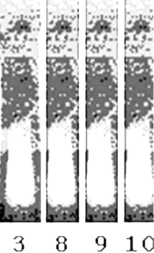 (画像データの類似性を解説したPDFファイル https://infotomb.com/r3hso.pdf)
(画像データの類似性を解説したPDFファイル https://infotomb.com/r3hso.pdf)
(1月16日 追記):このPDFを作成された方と匿名A氏とは別人だそうです。
ちなみに、平成26年8月26日付けの文部科学大臣決定「研究活動における不正行為への対応等に関するガイドライン」(下村博文 文部科学大臣)では、不正行為への対応に改定がありました。
第3節 研究活動における特定不正行為への対応
3 特定不正行為の告発の受付等
3-4 告発の受付によらないものの取扱い
③ 特定不正行為の疑いがインターネット上に掲載されている(特定不正行為
を行ったとする研究者・グループ、特定不正行為の態様等、事案の内容が明
示され、かつ不正とする科学的な合理性のある理由が示されている場合に限
る。)ことを、当該特定不正行為を指摘された者が所属する研究機関が確認
した場合、当該研究機関に告発があった場合に準じた取扱いをすることがで
きる。
今回のようなインターネットを利用した匿名による告発にも対応できるようにガイドラインが改善されています。
上で紹介した画像データ類似性解説PDFファイルの中身を見る限り、「類似」というよりも「同一」にしか見えないものが多いようです。単純な間違いでは説明できないものもあり、どうすればこのような「ミス」が起こりえるのかを考えるのは第三者には困難です。当事者である論文著者らの説明を聞くしかありません。研究不正の疑義が生じているわけですから、今後、該当する大学、研究機関が適切な対応を取ることが期待されます。
参考
- 捏造問題にもっと怒りを(日本の科学を考える):匿名A氏の全コメントが掲載されているウェブページ。
- 大阪大学等多数の研究機関の論文の不適切さについて(世界変動展望):記事のコメント欄に画像の類似性をまとめたPDFおよびパワーポイントのファイルへのリンクがありましたので、それを記事内で「画像データの類似性を解説したPDFファイル https://infotomb.com/r3hso.pdf」として紹介させていただきました。
- 平成27年年頭挨拶 平成27年1月5日 大阪大学総長 平野俊夫:”‥研究における不正行為の防止に対する体制も本年中に整える予定にしています。実施に際しましては、皆様のご協力をお願いします。教職員の皆様には、大学人としての見識を疑われることのないよう厳しく自らを律するとの固い決意をしていただきますように重ねてお願いします。大学としても、不祥事に対しては厳正に対応していく所存です。‥”
- 研究活動における不正行為への対応等に関するガイドライン 平成26年8月26日 文部科学大臣決定 (PDFファイル)
- 「研究活動における不正行為への対応等に関するガイドライン」に関する意見募集の結果について 平成26年8月26日 文部科学省科学技術・学術政策局人材政策課 (PDFファイル):”‥匿名の告発については、従前のガイドラインにおいても、顕名に準じた取扱いができることとしており、本ガイドラインにおいても、その方針を踏襲しています。他方、インターネットの発達により、不正行為の疑いに関する指摘が、必ずしも書面等を通じた告発による形式ではない場合も多く想定されるところ、本ガイドラインにおいては、インターネットでの指摘も告発があった場合に準じて取り扱うことができることとしました。‥”
- 新しい研究不正ガイドラインの論点 ―ガイドラインの課題とガイドライン後の課題― 調査と情報―ISSUE BRIEF― NUMBER 835(2014.11. 6.) (PDFファイル) 国立国会図書館 調査及び立法考査局文教科学技術調査室:”米国では研究の実施中に「データに変更を加えたり、データを省いたり」することは定義上、改ざんに相当する。「データを省く」には研究記録が存在しないことや研究記録の紛失等により適切に研究記録を提示できない場合も含まれる。一方、日本の新旧ガイドラインでは、研究途中の研究記録の改ざんは研究不正には該当せず、研究成果が掲載された論文に現れたデータや結果の改ざんのみが研究不正(特定不正行為)と判断される。米国の場合には、この研究不正の定義、改ざんの定義から、研究記録の不存在により、研究結果の真正性を示せないこと自体が改ざんであると判断されることになる。したがって、研究活動にとって研究記録は大変重要なものとなる。日本の新旧ガイドラインでは、研究途中の段階で改ざんが発覚したとしても、それを論文として発表しなければ、研究不正を問われることはない。しかし、後述するように新旧ガイドラインでも研究記録の不存在は研究不正と「みなされる」又は「認定される」根拠となる。”
- 『3位じゃダメなんです。』 (大阪大学 ニュース&トピックス 2015年1月16日):”12月28日(日)、29日(月)の日本経済新聞(全国版)朝刊に、大阪大学の広告を掲載しまし た。” “『3位じゃダメなんです。』阪大なら実現できる。世界トップ10の研究型総合大学を。ダメなんです。阪大は、日本で3番目の大学じゃダメなんです。海外 学術誌の掲載論文数や研究費の獲得など、国内3位の実績は数あれど、阪大が目指すべきものはそこじゃない。世界の大学、研究機関、企業が、真っ先にイメー ジする日本の大学、基礎研究や応用研究で、世界にインパクトを与える研究型総合大学になるのです。”
研究不正関連のその他の記事


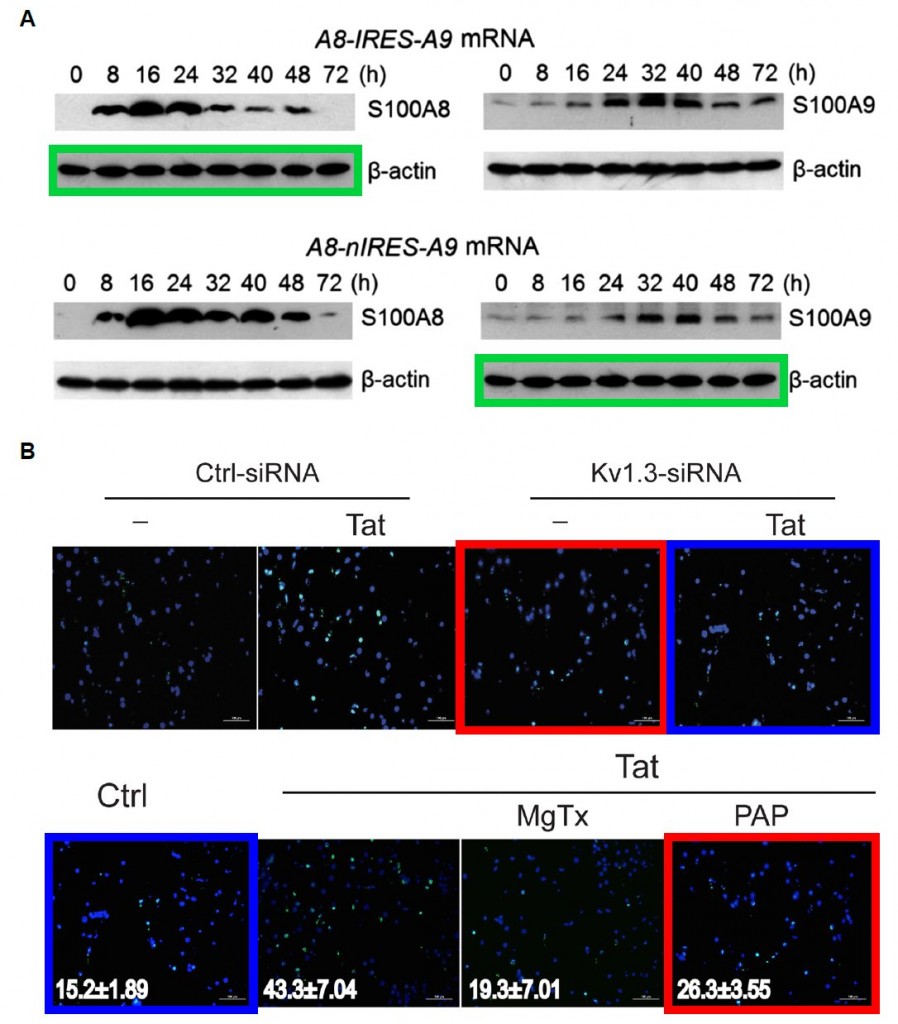
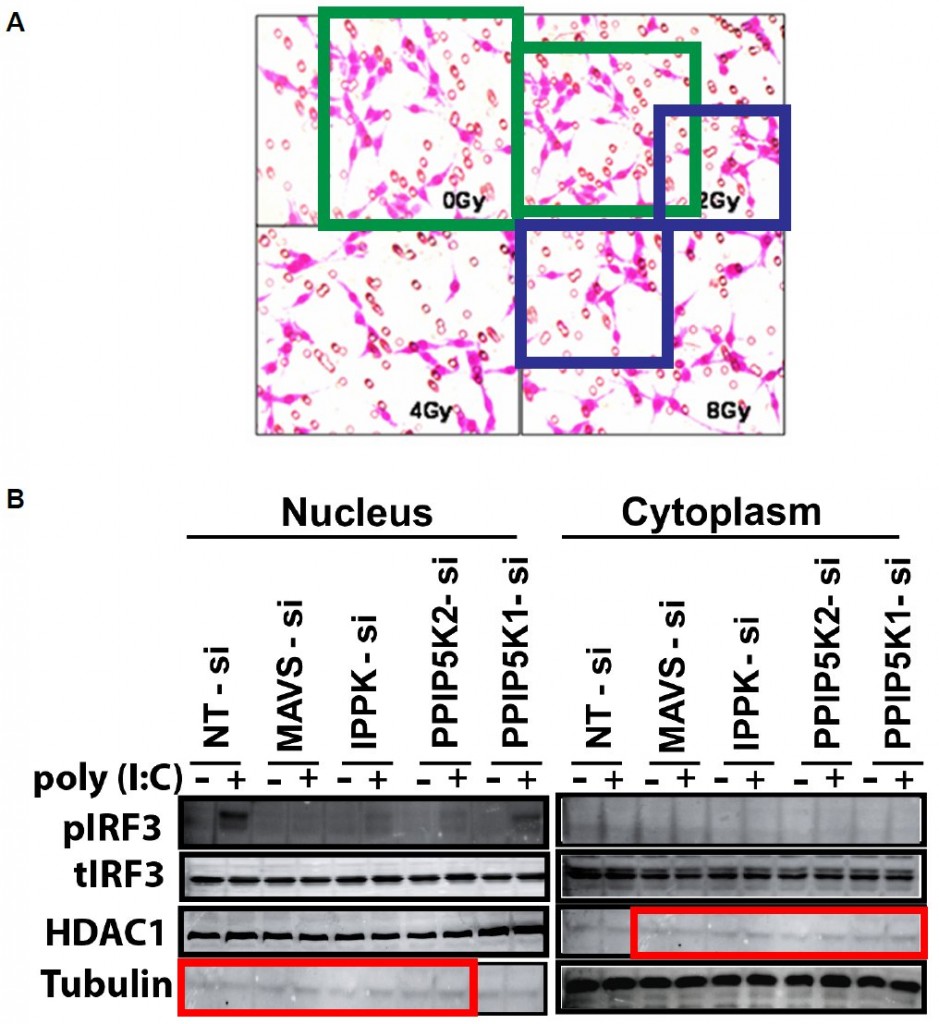 (引用元:
(引用元: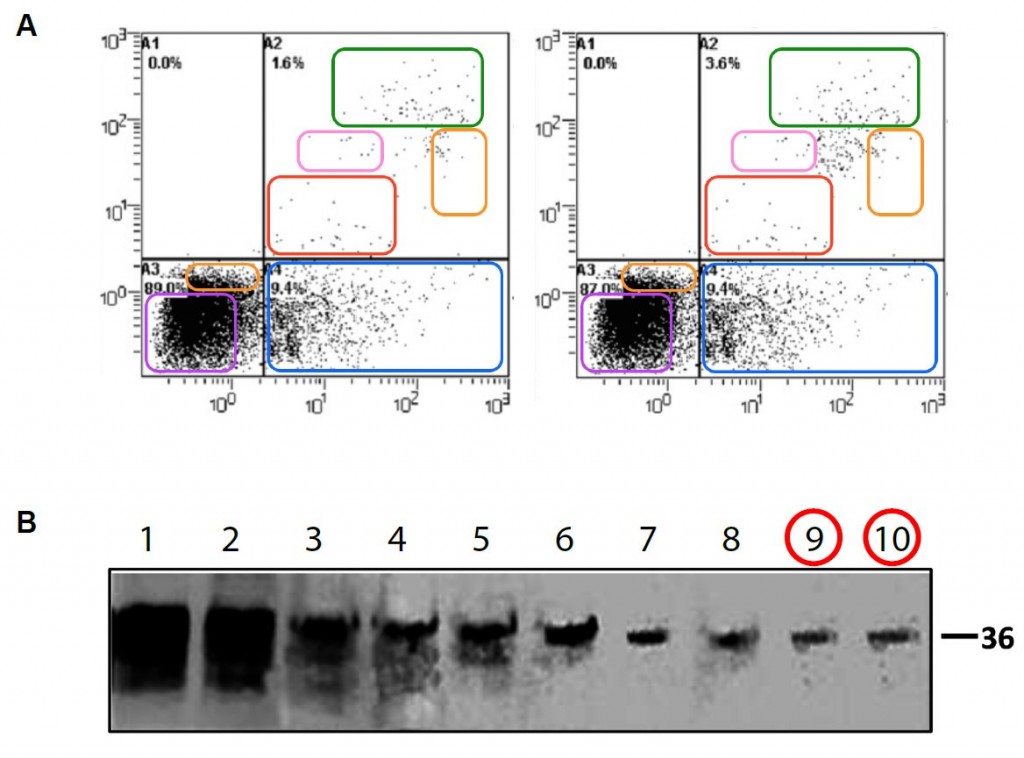 (引用元:
(引用元: